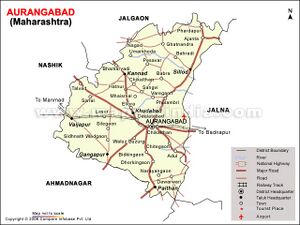Ajanta

Ajanta or is an ancient historical and religious place in Aurangabad district of Maharashtra. It is known for The Ajanta Caves which are 30 rock-cut Buddhist cave monuments which date from the 2nd century BCE to about 480 or 650 CE.[1]
Variants of name
Location
Ajanta Caves are located in north-east cornerof Aurangabad district of Maharashtra, near Jalgaon and just outside the village of Ajinṭhā 20°31′56″N 75°44′44″E, about 59 kilometres from Jalgaon railway station on the Delhi – Mumbai line and Howrah-Nagpur-Mumbai line of the Central Railway zone, and 104 kilometres from the city of Aurangabad. They are 100 kilometres from the Ellora Caves, which contain Hindu and Jain temples as well as Buddhist caves, the last dating from a period similar to Ajanta.
History
The caves include paintings and sculptures described by the government Archaeological Survey of India as "the finest surviving examples of Indian art, particularly painting", which are masterpieces of Buddhist religious art, with figures of the Buddha and depictions of the Jataka tales.[3] The caves were built in two phases starting around the 2nd century BCE, with the second group of caves built around 400–650 CE according to older accounts, or all in a brief period of 460 to 480 according to the recent proposals of Walter M. Spink. The site is a protected monument in the care of the Archaeological Survey of India,[4] and since 1983, the Ajanta Caves have been a UNESCO World Heritage Site.
The Ajanta caves are cut into the side of a cliff that is on the south side of a U-shaped gorge on the small river Waghur.
Like the other ancient Buddhist monasteries, Ajanta had a large emphasis on teaching, and was divided into several different caves for living, education and worship, under a central direction. Monks were probably assigned to specific caves for living. The layout reflects this organizational structure, with most of the caves only connected through the exterior. The 7th-century travelling Chinese scholar Xuanzang informs us that Dignaga, a celebrated Buddhist philosopher and controversialist, author of well-known books on logic, lived at Ajanta in the 5th century. In its prime the settlement would have accommodated several hundred teachers and pupils. Many monks who had finished their first training may have returned to Ajanta during the monsoon season from an itinerant lifestyle.
The caves are generally agreed to have been made in two distinct periods, separated by several centuries.

